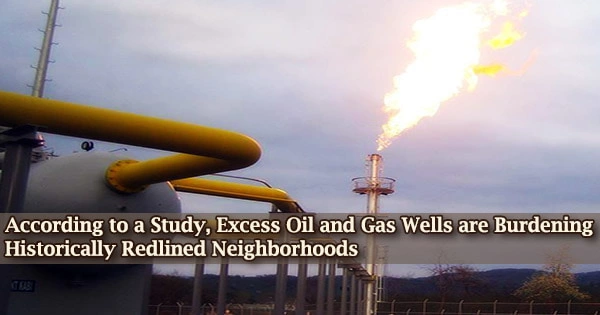In the United States, traditionally redlined communities with the lowest density of oil and gas wells have twice the density of comparable neighborhoods with the highest density. In redlined areas, wells are expected to contribute to disproportionate pollution and accompanying health issues.
The study was published in the Journal of Exposure Science & Environmental Epidemiology by the Columbia University Mailman School of Public Health, University of California Berkeley, and the University of California San Francisco researchers.
Residents near oil and gas wells are exposed to air and water pollution, noise, and other kinds of stress, which can increase the risk of a variety of diseases, including cardiovascular disease, lung function impairment, anxiety, depression, preterm birth, and fetal growth impairment. At least one operating oil or gas well is within one mile of an estimated 17 million Americans.
“We already know that people living in historically redlined neighborhoods have elevated risk of asthma, cardiovascular disease, preterm birth, and low birthweight. Our study helps explain one driver of these health disparities,” says first author David Gonzalez, Ph.D., a President’s Postdoctoral Fellow at UC Berkeley.
“Racially marginalized people have disproportionately high exposure to oil and gas-related contaminants, and we’re seeing that these 80-year-old racist policies related to housing segregation and mortgage risk played a role.”
Our study adds to the evidence that structural racism in federal policy is associated with the disproportionate siting of oil and gas wells in marginalized neighborhoods. These exposure disparities have implications for community environmental health, as the presence of active and inactive wells contribute to ongoing air pollution.
Joan Casey
“Our study adds to the evidence that structural racism in federal policy is associated with the disproportionate siting of oil and gas wells in marginalized neighborhoods,” says senior author Joan Casey, PhD, assistant professor of environmental health sciences at Columbia Mailman School. “These exposure disparities have implications for community environmental health, as the presence of active and inactive wells contribute to ongoing air pollution.”
Casey previously discovered that historically redlined districts are more likely to be devoid of green space now. Other studies have found that historically red-lined areas exhibit persistent social disparities.
Researchers analyzed oil and gas well exposure in HOLC-graded neighborhoods in 33 cities across 13 states where urban oil and gas wells were drilled and operated. They analyzed neighborhoods that were identical on observed 1940 sociodemographic parameters but earned varied ratings across the 17 cities for which census data were available.
The quantity and density of oil and gas wells were shown to be related to the HOLC score. These wells were operational both before and after the redlining maps were created. Signal Hill and Wilmington, both in Los Angeles, were two of the redlined communities with the most wells.
The Mapping Inequality project at the University of Richmond provided the researchers with digitized HOLC maps. They used the National Historical Geographic Information System’s Integrated Public Use Microdata Series to obtain census-tract level sociodemographic data from the 1940 census. Enverus Drillinglnfo, a data aggregation service, provided data on oil and gas wells dating back to 1898.
Both private firms and government entities, such the HOLC, which aimed to reduce mortgage foreclosures during the Great Depression, have maintained redlining during the last century.
HOLC personnel used neighborhood-level indicators such as property values, the existence of industrial facilities, and the prevalence of racially marginalized populations such as Black people and immigrants when assessing mortgage risk.
This study found a correlation between redlining and oil and gas well exposure, which could explain some of the current health inequities. Anthony Nardone of the University of California, San Francisco; Andrew Nguyen and Rachel Morello-Frosch of the University of California, Berkeley are co-authors.
The study was financed by the National Institute of Environmental Health Sciences (ES027023) and the California Air Resources Board (18RD018). There are no competing interests declared by the authors.





